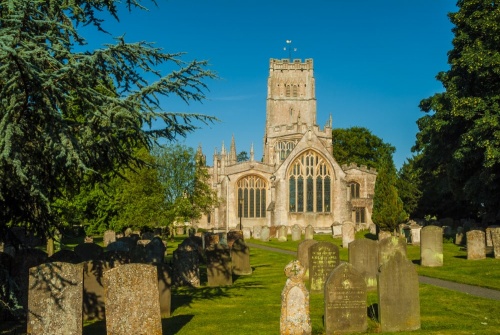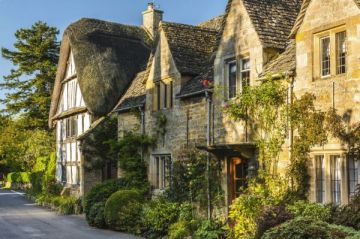
The Church of St Peter and St Paul, Northleach is one of the finest Cotswold wool churches - and that's saying something! The church has been called "The Cathedral of the Cotswolds", and with good reason. It seems at first glance quite odd that a small town like Northleach would possess such an extraordinary church, but the fact is easily explained with a little dose of history.
In the medieval period the Cotswold region was famous for the quality of the wool it produced. So prized was this wool that many wool merchants became fabulously wealthy by the standards of their time. Some of this wealth was lavished on their local churches.
In the case of Northleach, the greatest benefactor was John Fortey, who helped rebuild an earlier 14th-century church in the mid-15th century. Fortey's brass lies near the pulpit, and he is depicted in the modern stained glass of the east window, offering the church to God. It is the brasses that help make Northleach so memorable; for here is perhaps the best single collection of medieval and Tudor brasses in the country, a testament to the wealth of the local wool merchants.
Most of the merchants are depicted with their feet resting on woolpacks and/or sheep, and the brasses often show each merchant's individual woolmark, a symbol to keep track of which wool came from which trader.
The Northleach Brasses
Here's a look at the major brasses you can see in the church.
Starting in the north aisle, the westernmost brass dates to about 1400 AD and shows an unnamed wool merchant and his wife. He has a forked beard and a long gown tied by an ornate belt, from which hangs a dagger. His feet rest on a woolpack. His wife wears a cap and veil, with a kirtle under a mantle. A lap dog lies at her feet.

and his wife

The Scors/Fortey Brass
Moving up the north aisle is a large brass with three figures. In the centre is Agnes, flanked by her two husbands, Thomas Fortey and William Scors. It is striking to see a woman with two husbands rather than vice versa! The figure of William Scors shows a pair of scissors at his feet, signifying his trade as a tailor.
The inscription surrounding the three figures is fascinating; it describes the virtues of Thomas Fortey, including his repair of local churches and roads. Between the words are small figures of plants and animals including roses, acorns, and a slug. At the foot of the brass is the year of Thomas Fortey's death. What is very unusual is that the date is recorded as MCCCC47 (1447), a mix of Roman and Arabic numerals. This is thought to be the first use in England of Arabic numerals on a monumental brass.


John Fortey (1458)
In the shadow of the pulpit is the brass of Northleach's great benefactor, John Fortey (d. 1458). He is richly dressed, in a gown lined with fur. The gown is tied with a belt which bears a pendant inscribed with his woolmark. One foot rests on a woolpack, the other on a sheep. Fortey bequeathed 300 pounds to complete the restoration of the church, which had already begun by the time of his death. He also left money to every prisoner in Gloucester Castle and to 80 poor women on their marriage.



John Taylour (1490)
In the south aisle is a brass to John and Joan Taylor and their 15 children. Curiously, we know that the brass was made in 1490 but John died in 1509 and Joan a year later, so obviously they purchased the brass well before they died.


William and Agnes Midwinter (1501)
Nearest to the pulpit is a brass to yet another wool merchant, one foot resting on a sheep, the other on a woolpack. Midwinter served as High Bailiff in 1493. We know quite a bit about Midwinter's business career; he traded with the Cely company, Merchants of the Staple of Calais. The Cely's bought Cotswold wool, transported it by packhorse to London, where the weight was double-checked, then it was loaded on a ship for Calais.
The Cely's came to Northleach regularly for business meetings and much of their correspondence with William Midwinter has survived, giving us a fascinating glimpse into the medieval wool trade. It is interesting that Agnes Midwinter is shown with her feet on a sheep and woolpack, suggesting that she was a merchant in her own right.


Robert and Anne Serche (1501)
Just west of the John Fortey brass in the north aisle is probably the best preserved of all the Northleach brasses, to the Serche couple. Robert is clean shaven, with a purse hanging from his belt. Anne wears a kennel headdress, as does her daughter at the foot of the memorial. Here again, the date of death is oddly inscribed, using a mix of Latin numerals and English words. Note that Robert's feet do not rest on a sheep or woolpack, for he was not a wool merchant but a mercer (a cloth merchant).


Thomas and Joan Bushe (1525)
The youngest and most ornate of all the Northleach brasses, this shows yet another wealthy wool merchant, feet resting on a sheep and woolpack. Thomas wears a full-length gown over a doublet, while Joan wears a kennel headdress. Each effigy is shown under an intricate canopy depicting three sheep under a bush, an obvious rebus, or visual pun on the Bushe family name.
Thomas was a merchant of the Staple of Calais and owned property in Wiltshire, Oxfordshire, and Berkshire as well as here in Northleach. When Joan died she left her chaplain's vestments to the church. This led to a local story that she had bequeathed her wedding dress to be made into a cope, which was then made into an altar frontal. A piece of an altar frontal hangs on the wall nearby, so perhaps there is some truth to the story.


William Lawnder (1530)
On the south chancel floor is the only brass to a cleric, that of William Lawnder, or Lavender. He is clean shaven with a tonsure and is shown kneeling in an attitude of prayer.

Maud Parker (1584)
Something a little different! This peculiar brass on the Lady Chapel wall is an inscription in the form of an acrostic verse, where each line of the poem begins with the letters of the names Mawd Parker Thomas. Thomas Parker was the nephew of Abbot Thomas Parker, the last Abbot of Gloucester before the Reformation. Thomas lived to be 100 years old and died in 1628.

On the north west wall of the chapel are several small brasses to the children of William and Margaret Bicknell, who paid to have the chapel built in 1489. Look up at the stone corbels supporting the roof. The crowned king is supposed to represent Henry Tudor (Henry VII) and the rather grim looking queen is said to be Elizabeth of York, his wife.



Other Features
The south porch
In my eyes, this is one of the highlights of late Perpendicular architecture in England, a superb piece of Gothic style. The two-storey exterior is decorated with pinnacles, statues, and all manner of embellishments. The interior is even better, with a wonderfully ornate vaulted ceiling which terminates in carved head corbels. One of these corbels, on the west side of the porch, shows a grinning Green Man, the symbol of fertility. Above the vaulted entry is a parvise; a hidden chamber used as a residence for a priest. More recently it was used for Sunday school.



The lovely stone pulpit is 15th century, carved in the shape of a wine glass with a slender stem at the base. Even more intricate is the 14th-century font near the door. This is seemingly carved on every surface, especially the underside of the bowl, where angels are depicted playing musical instruments. These lower figures can be difficult to see without contorting yourself, but thankfully someone has thought to place a mirror on the floor beneath the font so you can get a good look at the carvings without too much discomfort! At the base are small carved devils, being symbolically crushed by the power of baptism.



At the east end of the south aisle is a screen separating the aisle from the Lady Chapel beyond, and the screen is decorated with niches above a small altar. The niches clearly show traces of medieval wall painting, though much of the detail has been lost.

Visiting
The church is usually open daylight hours. When I last visited this was 10-dusk, but it is worth checking the church website before making a trip. I live about 15 minutes away from Northleach so I've managed to visit on several occasions, and each time I come away awed by the amazing architecture, especially of the south porch and tower, and by the wonderful brasses. There's a fairly inexpensive brochure covering all the brasses. It was 1 pound last time I looked, and very good value, for it can help see details that you might otherwise miss. Northleach truly deserves its reputation as one of the finest wool churches in England.
About Northleach, St Peter and St Paul
Address: Northleach,
Cotswolds,
Gloucestershire,
England
Attraction Type: Historic Church
Location: Just behind the market square in the centre of Northleach, where there is free parking. Usually open daylight hours.
Website: Northleach, St Peter and St Paul
Location map
OS: SP111146
Photo Credit: David Ross and Britain Express
POPULAR POSTS
HERITAGE
 We've 'tagged' this attraction information to help you find related historic attractions and learn more about major time periods mentioned.
We've 'tagged' this attraction information to help you find related historic attractions and learn more about major time periods mentioned.
Historic Time Periods:
Find other attractions tagged with:
14th century (Time Period) - 15th century (Time Period) - brass (Historical Reference) - castle (Architecture) - Decorated (Architecture) - Henry VII (Person) - Medieval (Time Period) - Perpendicular (Architecture) - Reformation (Historical Reference) - Restoration (Historical Reference) - Roman (Time Period) - Tudor (Time Period) - wall painting (Historical Reference) -
NEARBY HISTORIC ATTRACTIONS
Heritage Rated from 1- 5 (low to exceptional) on historic interest
Hampnett, St George's Church - 1 miles (Historic Church) ![]()
Turkdean, All Saints Church - 1.6 miles (Historic Church) ![]()
Stowell, St Leonard's Church - 1.8 miles (Historic Church) ![]()
Yanworth, St Michael's Church - 2.1 miles (Historic Church) ![]()
Lodge Park - 2.6 miles (Historic House) ![]()
Coln St Dennis Church - 2.8 miles (Historic Church) ![]()
Hazleton, St Andrew's Church - 3 miles (Historic Church) ![]()
Notgrove, St Bartholomew's Church - 3.3 miles (Historic Church) ![]()
Nearest Holiday Cottages to Northleach, St Peter and St Paul:
Bourton-on-the-Water, Gloucestershire
Sleeps: 4
Stay from: £818 - 2861
Northleach, Gloucestershire
Sleeps: 4
Stay from: £758 - 3452
More self catering near Northleach, St Peter and St Paul









